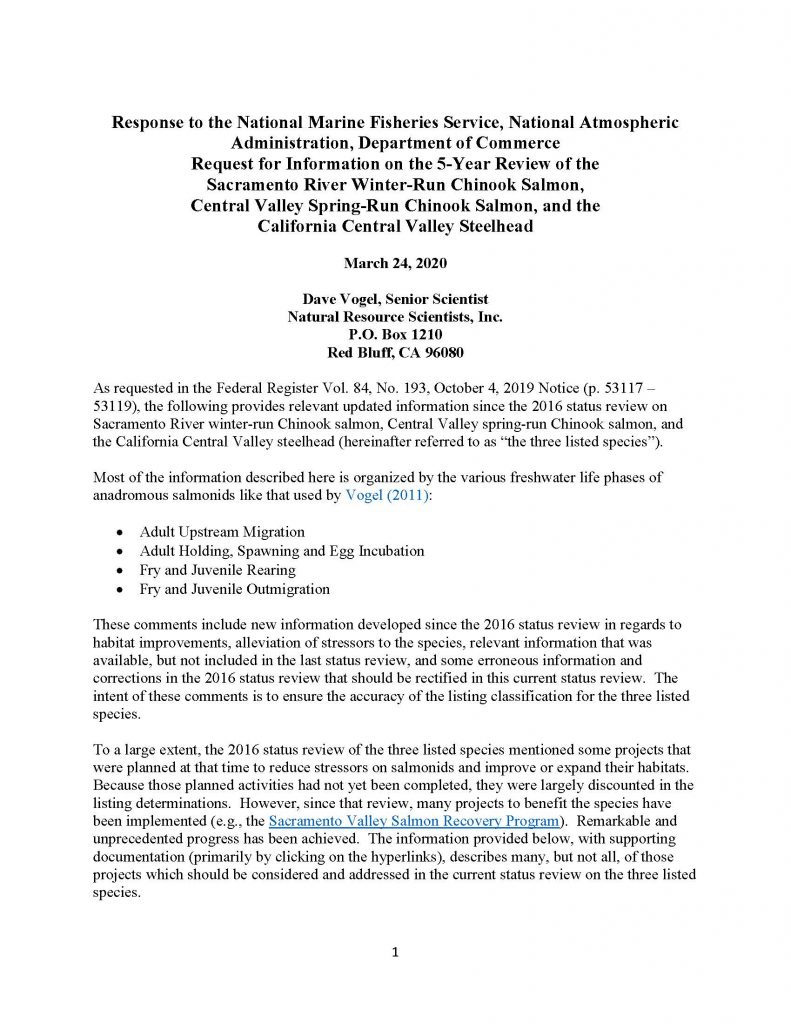By Dave Vogel, Senior Scientist, Natural Resource Scientists, Red Bluff
Earlier this year, I provided the National Marine Fisheries Service (NOAA Fisheries) with comments on its 5-year Review of the Sacramento River Winter-run Chinook salmon, Central Valley Spring-run Chinook salmon and the California Central Valley Steelhead. As a scientist working in the Sacramento Valley for most of my career, the purpose of my comment letter was to provide my perspective to NOAA Fisheries on new information that had been developed since the last status review of the species in 2016.

The most apparent observation I had after developing the comments was the substantial amount of work that has been undertaken in the Sacramento Valley to complete habitat projects and advance science for Chinook salmon recovery in the last 5 years. It can be easy to lose track of the magnitude of work that has been accomplished during this time, as the announcement of the completion of one project is quickly followed by that of another. But, when tasked with chronicling the projects that have been completed, it is a quick reminder of the quantity of work that has been achieved. See pages 2 through 9 in my comments for the list of completed projects to provide habitat benefits for Chinook salmon during all of their freshwater life cycle stages (Adult Upstream Migration, Adult Holding, Spawning and Egg Incubation, Fry and Juvenile Rearing, and Fry and Juvenile Outmigration).
Another over-arching observation is the role successful collaborations have had in completing salmon recovery projects. Each of the projects was completed with the help of many partners, including water management entities, state and federal agencies and conservation organizations. The collaborations allowed the various entities to provide their specific skills and resources to assist in the advancement of the project, resulting in the substantial number of completed projects.
During this time, there also have been advancements in the science and our understanding of factors influencing salmon recovery. As an example, we are learning more about the impact predation is having on out-migrating juvenile salmon and how lighting of structures in the river increases predation. In addition, the drought years of 2014 and 2015 exposed several flaws in monitoring and modeling methods used to create survival and population estimates of juvenile Chinook salmon. In particular, the use of juvenile fish monitoring 50 miles downstream of the spawning area to develop estimates of the effect of temperature in egg survivability required the use of several modeling assumptions that generated results that over-estimated mortality anywhere from 76 to 93 percent. See pages 9 through 13 in my comments for more detailed information on the problems with the monitoring and modeling and how this led to inaccuracies in estimates of juvenile fish mortality and the effect of temperature on fish survival. The identification of the problems with the monitoring and modeling will now allow the parties engaged in the process to work together to address the flaws and improve the estimates so that they can better inform efforts to recover Chinook salmon.
This effort to develop comments on the 5-year review has provided a great opportunity to reflect on the work that has occurred, the efforts that are underway and the improvements that still need to occur to advance salmon recovery in the Sacramento Valley. Please click on the document below to see more detail.




